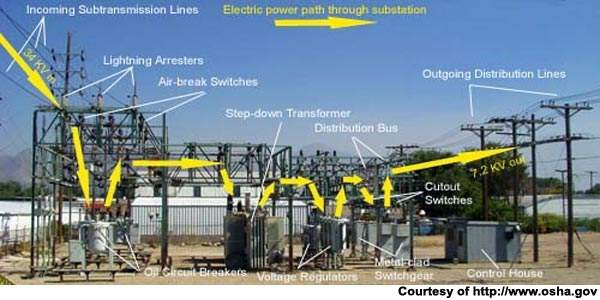
In today’s world of power shortages, increasing demand and the energy efficiency debate, how the electricity network is run right through from the power station to switch on the wall is becoming ever more important. Power companies are now realising that the substation, while a lot less ‘sexy’ than carbon coal sequestration projects, for example, can play just a big a part in ensuring the power station meets all modern desires.
For years the substation has been overlooked, as old technology and insufficient metering control still seemed to cause problems.

Discover B2B Marketing That Performs
Combine business intelligence and editorial excellence to reach engaged professionals across 36 leading media platforms.
But now power companies are starting to pay more attention to potential changes that will drive efficiencies to these once neglected parts of power distribution: isolating faults, updating switchgear, monitoring and controlling substations and using automation, all while maintaining a strong level of security and safety.
Less common is the move by some power stations to allow collector substations to gather power from renewable resources like wind turbines, normally stepping up the voltage to connect to the grid. These will often use control circuits and meters, along with power factor correction to ensure this power source is used to its maximum benefit.
But there are some more prominent trends in the industry that are making power substations an integral part of power supply and energy efficiency.
ISOLATING FAULTS RAPIDLY

US Tariffs are shifting - will you react or anticipate?
Don’t let policy changes catch you off guard. Stay proactive with real-time data and expert analysis.
By GlobalDataThe highest priority in a substation is to detect and isolate failures in the transmission system as quickly as possible. Short-circuit or overload currents in large substations can leave thousands of people without electricity.
Current transformers often detect such large fault currents, with high-voltage power circuit breakers tripping within tens of milliseconds. Short-circuit currents can be nearly 100,000A, so current arcs across the contacts. This is normally extinguished by blowing a high-pressure gas jet across the arc.
ABB has studied arc phenomenon and found most switchgear arcing accidents to be caused by human interference during maintenance, installation or even simple inspection. Arcing occurs when current breaks through insulation to earth or another phase. In an instant, 40MW can be generated. Arc temperatures may reach 20,000°C and cause an explosion and fire.
Conventional systems use multiple light sensors in an enclosure. ABB’s REA protection system detects arcs anywhere within the switchgear enclosure, using an unshielded fibre-optic cable run around the switchgear enclosure’s interior.
It senses the intense light from a developing arc, with fast IGBT solid-state circuits instantly triggering isolation of the arc before it can cause damage. The system can be retrofitted to extend the life of older switchgear, which is more prone to arc faults.
GAS INSULATED SWITCHGEAR
Conventional air-insulated switchgear substations are now often being replaced by gas-insulated switchgear (GIS) types. GIS uses circuit breakers with a high-pressure sulphur hexafluoride gas to insulate the live switch elements. GIS needs 25% less space, thereby reducing land costs, particularly in urban areas.
Areva’s F35 high-voltage gas-insulated substation, for example, is designed for up to 145kV three-phase (indoor) operation. The rated voltage is 72/145kV, rated frequency is 50/60Hz, rated current 2,500/3,150A and short-time withstand current (3s) is 31.5/40kA.
Gas circuit breakers (GCB) and gas-insulated transformers (GIT) are becoming similarly popular. However, sulphur hexafluoride been identified as a greenhouse gas, so measures are needed to limit release to the atmosphere.
SUBSTATION MONITORING, CONTROL AND AUTOMATION
Microprocessor-based controllers are increasingly allowing remote communications. This allows information and status of several substations to be accessed centrally, with operators monitoring status and responding quickly. Some instruments may not then be needed at the substation itself, saving on costs. Protective actions can also be analysed centrally, meaning there is less need for site maintenance visits.
EA Technology produces a multi-node multichannel substation monitor. With both permanent and semi-permanent installation, it can monitor many substation parameters. It detects partial discharges using up to 100 nodes, which can be distributed anywhere on the surface of switchgear equipment.
Each node can have a transient earth voltage (TEV) probe, or an aerial, or up to six ultrasonic probes attached. The nodes constantly measure TEV and ultrasonic activity to provide an accurate picture of the switchgear insulation condition and any sign of breakdown.
Substation automation in general enhances the overall reliability of power networks. Communication protocols transmit the data, but have traditionally covered individual subsystems. For example, proprietary systems have often been used to communicate between protection devices and the station controller.
Equipment from different manufacturers often could not communicate except across gateways, but this is now addressed by the IEC 61850 standard. Monitoring in substations has also often concentrated on individual pieces of equipment, but there are benefits in monitoring the complete substation.
MAINTAINING SUBSTATION POWER QUALITY
Maintaining power quality is one of a power operator’s most important objectives, and it affects operating conditions of the whole transmission and distribution networks. Power quality information is of strategic importance for electricity companies and essential for ensuring competitive operation.
Portable or fixed-power quality measurements can acquire data giving the power quality of the various transmission network nodes. Complex long-term measurements may be needed to determine the equipment causing any disturbances and optimise the network as a whole.
Where measurements or other considerations suggest that new substations will be needed, utilities should beware of uncontrolled expansion.
Under/over-utilisation and unplanned development can cause problems like high losses, poor reliability, and voltage and power quality problems.
There is also one other option that is rarely considered when planning an expansion. With substations, as elsewhere, reducing energy demand by helping implement energy efficiency measures at consumer premises can push back or even remove the need for the upgrades. And that, as elsewhere, saves costs all up the line.





